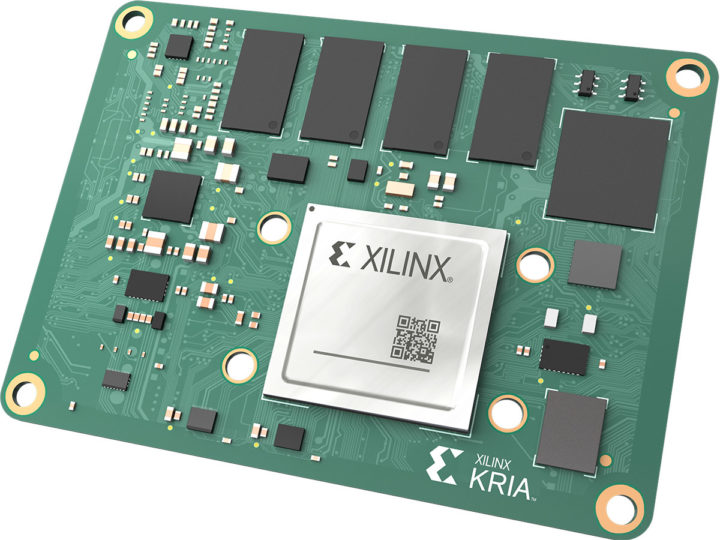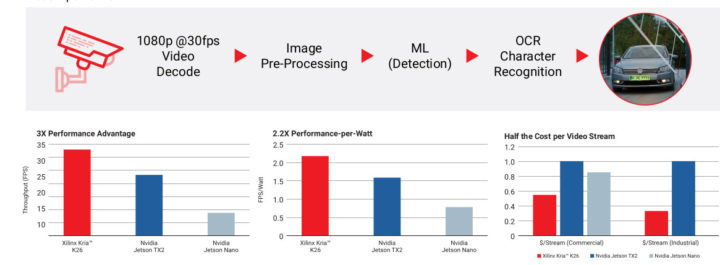Silicon vendors will usually focus on chip design, and provide an expensive evaluation kit to early customers, leaving the design of cost-optimized boards and system-on-modules to embedded systems companies.
But Xilinx has decided to enter the latter market with the Kria portfolio of adaptive system-on-modules (SOMs) and production-ready small form factor embedded boards starting with Kria K26 SoM powered by Zynq UltraScale+ XCK26 FPGA MPSoC with a quad-core Arm Cortex-A53 processor, up to 250 thousand logic cells, and a H.264/265 video codec designed for Edge AI applications, as well as computer vision development kit.
Kria K26 System-on-Module
Kria K26 module specifications:
- MPSoC – Xilinx Zynq Ultrascale+ custom-built XCK26 with quad-core Arm Cortex-A53 processor up to 1.5GHz, dual-core Arm Cortex-R5F real-time processor up to 600MHz, Mali-400 MP2 GPU up to 667MHz, 4Kp60 VPU, 26.6Mb On-Chip SRAM, 256K logic cells, 1,248 DSP slices
- System Memory – 4GB 64-bit DDR4 (non-ECC)
- Storage – 16GB eMMC flash, 512 Mbit QSPI flash
- 2x 240-pin board-to-board connectors with
- High-Speed PS Connectivity (GTR) – PCIe Gen2 x4, 2x USB3.0, SATA 3.1, DisplayPort, 4x Tri-mode Gigabit Ethernet
- General PS Connectivity (MIO) – 2xUSB 2.0, 2x SD/SDIO, 2x UART, 2x CAN 2.0B, 2x I2C, 2x SPI, 4x 32b GPIO
- Transceivers
- 4x GTH 12.5Gb/s Transceivers for PCIe Gen3 x4, SLVS-EC, HDMI 2.0, DisplayPort 1.4
- 4x GTR 6Gb/s Transceivers
- 52x PS MIO (1.8V)
- 69x PL High-density (HD) I/O (3.3V)
- 116x PL High-performance (HP) I/O (1.8V)
- Security – Infineon TPM 2.0
- Power Consumption – 7.5W typ., 15W max.
- Dimensions (with heat spreader) – 77 x 60 x 11mm
- Speed and Temperature Grade
- Commercial – -2 speed grade, low voltage, and 0 to 85°C temperature range
- Industrial – -2 speed grade, low voltage, and –40 to 100°C temperature range
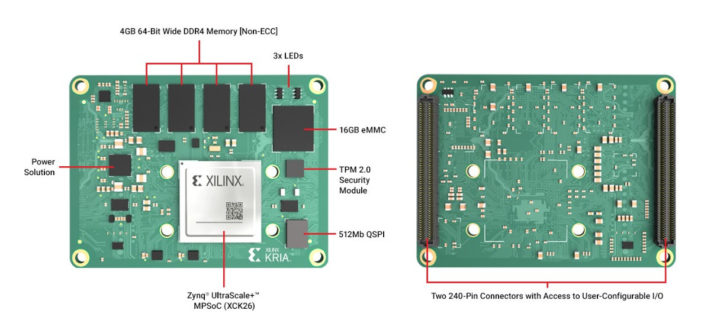
The company provides Yocto-based PetaLinux and Ubuntu Linux distributions, as well as an app store with pre-built accelerated applications for common vision applications. The module supports TensorFlow, Pytorch and Caffe frameworks, as well as C, C++, OpenCL, and Python programming languages through the Vitis unified software development platform and libraries.
Typical applications include security, traffic and city cameras, retail analytics, machine vision, and vision-guided robotics. The commercial version of Kria K26 module will sell for $250, while the industrial-grade SoM goes for $350 both with 10 years longevity, but the industrial module has a longer warranty (3 vs 2 years), and expected lifetime (10 vs 5 years).
Kria KV260 Vision AI Starter Kit
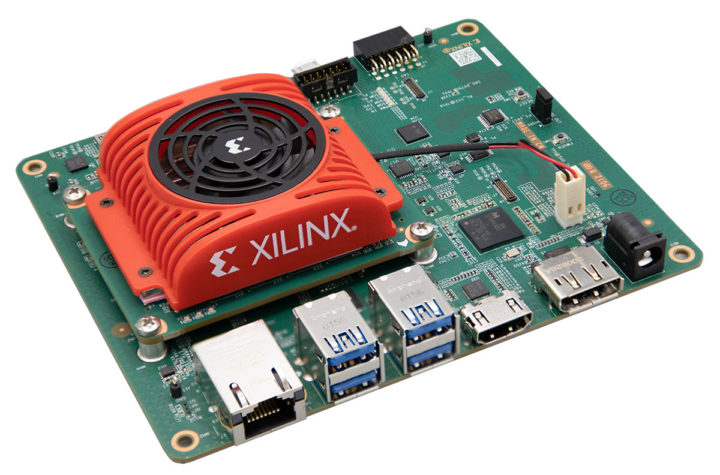
Xilinx is also offering a starter kit to get started with Kria K26 SoM.
Kria KV260 Vision AI Starter Kit specifications:
- SoM – Kria K26 described above
- Storage – MicroSD card slot (secondary boot device after on-module 512Mbit QSPI flash)
- Video Output – HDMI 1.4 port, DisplayPort 1.2a
- Camera
- OnSemi AP1302 ISP
- 2x IAS MIPI sensor interfaces
- 1x Raspberry Pi camera interface
- Networking – Gigabit Ethernet
- USB – 4x USB 3.0/2.0 ports
- Expansion – 12-pin Pmod interface
- Security – Zynq UltraScale+ MPSoC hardware root of trust (RoT) in support of secure boot, Infineon TPM2.0 in support of measured boot.
- Debugging – Micro USB UART/JTAG port, JTAG header
- Misc – Fan power
- Power – DC jack
- Dimensions – 140 x 119 x 36mm
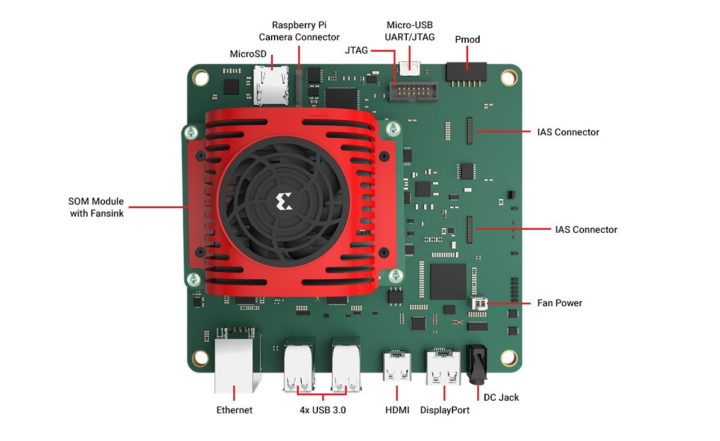
That means Xilinx now competes directly against customers that offer similar products such as MYiR Tech MYC-CZU3EG or UltraZed-EG SoM, although technically they could always say they do not as XCK26 is custom-built, so no other vendor can provide exactly the same type of hardware…
More details about the module and devkit may be found on the product page, and the starter kit can be purchased for $199 directly on Xilinx website or through distributors.
Via Hackster.io

Jean-Luc started CNX Software in 2010 as a part-time endeavor, before quitting his job as a software engineering manager, and starting to write daily news, and reviews full time later in 2011.
Support CNX Software! Donate via cryptocurrencies, become a Patron on Patreon, or purchase goods on Amazon or Aliexpress


